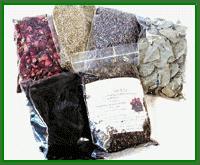


All herbs listed throughout this site are for Minnesota Hardiness Zones 4 and below.
Using herbs in the kitchen is definately nothing new, but using fresh herbs from your garden will give your foods a richer more flavorful taste. When substituting fresh herbs for dried herbs in a recipe, you will need to use about twice as many fresh as you would dried. Be willing to experiment with different herbs to acheive your desired tastes. Get into the habit of using your herbs daily, there is no limit to what they can enhance.
Italian Herb Blend
In a large bowl, combine 1 cup dried parsley, 1 cup dried basil, 1/2 cup dried minced onion, 1/4 cup dried minced garlic, 1/4 cup dried thyme, 2 tablespoons crushed dried red peppers, and 2 tablespoons dried sage. Blend together thoroughly. Store in an airtight container in a cool dark place. Use this Italian blend in spaghetti sauce or pizza sauce. Try this blend with hamburgers and garden salads too.
Salt-Free Herb Seasoning
In a large bowl, combine 1/2 cup dried dill, 1/2 dried minced onion, 2 tablespoons dried thyme 1 tablespoon dried cilantro, 1 tablespoon dried oregano, 2 teaspoons lovage or celery seed, 2 teaspoons minced garlic, and 1 teaspoon paprika. Grind all the ingredients together and store in an airtight container. Use this instead of salt.
Making your own herbal tea
Pour boiling water over dried or fresh herbs, usuallu about 1 teaspoon to 1 tablespoon of herbs per cup of water. Let it sit for about 5 to 10 minutes. Strain through a cheese cloth, your herb tea is ready to drink-hot or cold.
Learn about herbs that are used forHealth & Beauty

Annuals
Biennials
Perennials